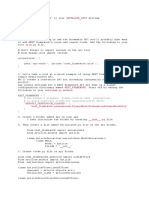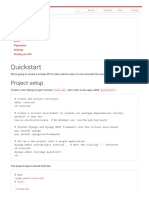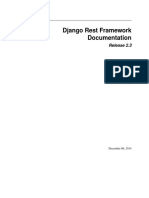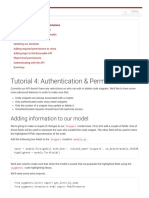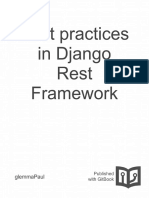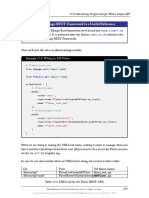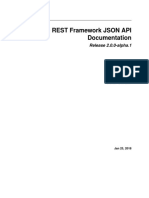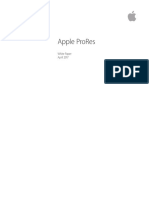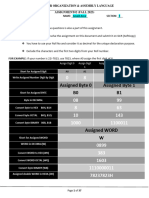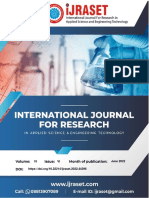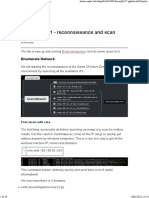To create a custom API for your Django system, you'll follow a series of steps that enable your
application to expose specific data and functionalities through endpoints, which other systems can
interact with. Django makes this easier with Django REST Framework (DRF), which is a powerful toolkit
for building Web APIs. Here's how you can set up your own custom API using Django and Django REST
Framework:
Steps to Create a Custom API in Django:
1. Install Django REST Framework (DRF)
First, you'll need to install Django REST Framework (DRF), which is commonly used for building APIs in
Django.
```bash
pip install djangorestframework
```
2. Update `settings.py`
Add `'rest_framework'` to your `INSTALLED_APPS` in `settings.py`:
```python
INSTALLED_APPS = [
# your other apps
'rest_framework',
```
3. Create a Serializer
A serializer is used to convert complex data types (like Django models) into JSON (or other content
types) and vice versa.
For example, if you have a model called `Product`, create a serializer for it.
```python
from rest_framework import serializers
from .models import Product
class ProductSerializer(serializers.ModelSerializer):
class Meta:
model = Product
fields = '__all__' # Or specify particular fields ['name', 'price', 'description']
```
4. Create Views for Your API
There are multiple ways to create API views using DRF:
- Function-based views (FBV) for simpler APIs.
- Class-based views (CBV) for more flexibility.
Example of a simple function-based view:
```python
from rest_framework.decorators import api_view
from rest_framework.response import Response
from .models import Product
from .serializers import ProductSerializer
@api_view(['GET'])
def product_list(request):
products = Product.objects.all()
serializer = ProductSerializer(products, many=True)
return Response(serializer.data)
```
Example of a class-based view:
```python
from rest_framework import generics
from .models import Product
from .serializers import ProductSerializer
class ProductList(generics.ListCreateAPIView):
queryset = Product.objects.all()
serializer_class = ProductSerializer
```
5. Configure URL Routing
To map your views to URLs, create routes in your `urls.py` file.
Example in `urls.py`:
```python
from django.urls import path
from .views import product_list, ProductList
urlpatterns = [
# For function-based view
path('api/products/', product_list, name='product-list'),
# For class-based view
path('api/products/', ProductList.as_view(), name='product-list'),
```
6. Test Your API
Run your Django server and navigate to the API endpoint (`/api/products/`) in your browser or use a
tool like [Postman](https://www.postman.com/) or `curl` to test your API:
```bash
curl http://127.0.0.1:8000/api/products/
```
This should return a JSON response with a list of all products in your database.
7. Adding POST, PUT, DELETE Requests
If you want your API to support creating, updating, and deleting resources, you can implement those
functionalities in your views.
For example, a class-based view for handling all CRUD operations:
```python
from rest_framework import generics
from .models import Product
from .serializers import ProductSerializer
class ProductDetail(generics.RetrieveUpdateDestroyAPIView):
queryset = Product.objects.all()
serializer_class = ProductSerializer
```
Update your `urls.py` to include the detail view for individual product retrieval, update, or deletion:
```python
urlpatterns = [
path('api/products/', ProductList.as_view(), name='product-list'),
path('api/products/<int:pk>/', ProductDetail.as_view(), name='product-detail'),
```
You can then make GET, PUT, DELETE requests to `/api/products/<id>/` to interact with individual
product records.
8. Authentication and Permissions (Optional)
You may want to restrict access to your API, allowing only authenticated users or certain roles to
access or modify data.
To add authentication and permissions:
```python
from rest_framework.permissions import IsAuthenticated
from rest_framework.authentication import TokenAuthentication
class ProductList(generics.ListCreateAPIView):
queryset = Product.objects.all()
serializer_class = ProductSerializer
authentication_classes = [TokenAuthentication]
permission_classes = [IsAuthenticated]
```
Make sure to also install and set up Django's token authentication if you're using it:
```bash
pip install djangorestframework-simplejwt
```
Update `settings.py`:
```python
REST_FRAMEWORK = {
'DEFAULT_AUTHENTICATION_CLASSES': (
'rest_framework_simplejwt.authentication.JWTAuthentication',
),
```
9. Testing in Postman or Curl
After setting everything up, test the endpoints with Postman or any API client to see how it behaves
with GET, POST, PUT, and DELETE requests.
Example POST request (creating a new product):
```bash
curl -X POST -d "name=New Product&price=29.99" http://127.0.0.1:8000/api/products/
```
---
Key Points:
- Django REST Framework is essential for building custom APIs in Django.
- Use Serializers to convert your Django models into JSON or other formats.
- Function-based views (FBVs) or Class-based views (CBVs) can handle API logic.
- Test your API using Postman or curl to ensure it works correctly.
Would you like to go deeper into any specific part of the API creation process?




